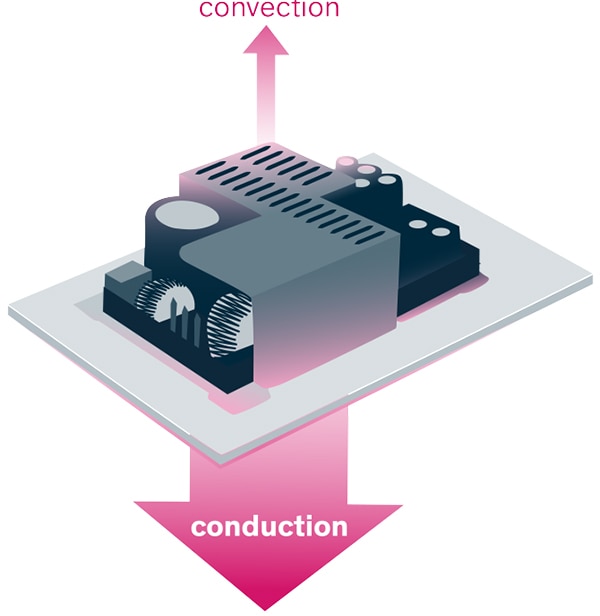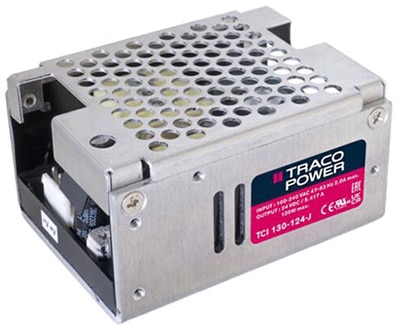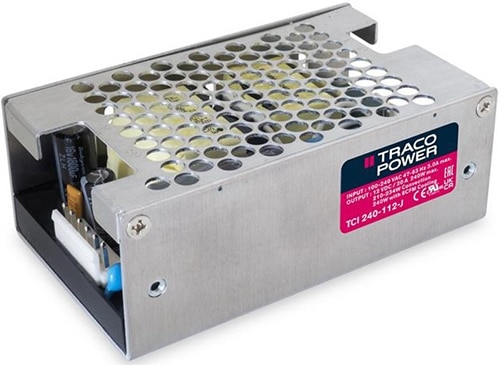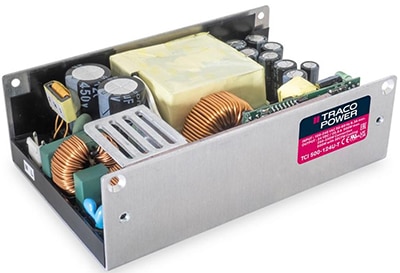Switched Power Supplies with Hybrid Conduction and Convection Cooling
Contributed By DigiKey's North American Editors
2025-02-19
Electronic applications generate heat that, when excessive, can reduce efficiency, shorten components’ lifespans, and even lead to thermal failure. Fan-based power supplies are favored for many applications, but not for those where efficiency, silence, and reliable performance are paramount.
Various cooling methods are used to maintain optimal operating temperatures, each with its own tradeoffs. Traditional power supplies rely on either forced-air cooling, which employs fans to actively move air across heat-generating components, or passive convection cooling, which relies on heatsinks and airflow to dissipate heat. Other options include conduction cooling and liquid cooling.
TRACO Power offers a series of fanless power solutions for industrial, medical, and telecom applications. The company's TCI series enables enhanced thermal management that reduces heat-related energy losses and improves system reliability for continuous operation. They provide a conduction cooled power solution using a proper baseplate, with the option to use convection cooling as well as forced air cooling, making them highly versatile for a range of applications.
Sorting through options
Each cooling method presents trade-offs in efficiency, size, cost, and reliability. When designing cooling systems for electronics, product designers should consider:
- Power dissipation requirements
- Space constraints
- Reliability needs
- Cost and complexity
By selecting the appropriate cooling strategy, designers can improve efficiency, reliability, and performance across various electronic applications. These are the typical cooling methods that should be considered in developing applications:
- Convection: Convection cooling relies on the natural movement of rising warm air being replaced by cooler air, allowing heat dissipation without any active components. It is low-cost and reliable but limited in effectiveness, especially in enclosed spaces where airflow is restricted. Passive convection cooling provides high reliability but is not suitable for high-power applications that generate significant heat.
- Forced Air: Forced air cooling uses fans to actively move air across heat-generating components for improved heat dissipation. This method is commonly used in industrial power supplies, computing systems, and high-power electronics. Fans consume power and introduce noise and potential failure points, but they effectively prevent overheating and thermal throttling to maintain system stability in demanding environments.
- Heatsinks: Heatsinks use thermal conduction to transfer heat from components to a larger surface area, allowing heat to dissipate into the surrounding air. Most heatsinks feature finned designs to maximize surface area, improving cooling through natural or forced convection. While thin-profile heatsinks exist for compact applications, larger heatsinks are typically required for high-power dissipation.
- Cold Plates: Cold plates use a thick metal baseplate to conduct heat away from a component, distributing it over a larger area.
- Liquid Cooling: Liquid cooling is dependent on a closed-loop system where coolant absorbs heat from components and transports it to a radiator or heat exchanger for dissipation. This method is commonly used in high-power applications such as aerospace, automotive, and high-performance computing, where fans and heatsinks alone are insufficient. However, liquid cooling requires additional engineering, complexity, and maintenance.
- Thermal Compounds: Thermal compounds, such as thermal paste or grease, reduce thermal resistance between electronic components and cooling surfaces but do not dissipate heat on their own. By filling microscopic air gaps, these compounds improve heat transfer efficiency, ensuring that heatsinks, cold plates, or heat spreaders can function effectively. Some thermal compounds also serve as adhesives to attach cooling solutions without mechanical fasteners.
TRACO Power's hybrid design
TRACO Power’s TCI series of switching power supplies utilize a hybrid case design that supports both convection and conduction cooling (Figure 1), making it highly versatile for different thermal management strategies.
 Figure 1: TRACO Power's hybrid case design provides designers with conduction and convection cooling options. (Image source: TRACO Power)
Figure 1: TRACO Power's hybrid case design provides designers with conduction and convection cooling options. (Image source: TRACO Power)
For conduction cooling, the metal casing ensures efficient heat transfer to an attached baseplate, heatsink, or chassis, allowing for passive dissipation of heat. This may be a preferred approach for sealed enclosures where forced airflow using fans is not practical or possible.
The encapsulated internal components are thermally connected, which optimizes heat spreading and allows natural convection to remove excess heat. When mounted in open air, the hybrid design in many cases still allows passive cooling without requiring additional heatsinks.
The TCI series offers superior thermal capabilities by combining the best features of conduction and convection case types. It can generate significantly higher power levels without the need for a fan within the same form factor as traditional power supply designs. In a conduction-cooled setup, according to TRACO Power, the TCI series can deliver up to 100% of its rated maximum output power, making it an ideal choice for fan-less application setups.
The hybrid design of the TCI series provides optimal heat transfer using an appropriate baseplate and the efficient thermal connection of the individual components through a special potting compound. The advanced compound enables the individual components to operate at peak efficiency, which is difficult to achieve with conventionally designed power supply systems.
The TCI series is specifically designed for conduction-cooled solutions involving 130 W to 500 W power requirements, making them especially useful for fanless applications. With an appropriate baseplate, they can operate safely at up to 100% of their rated power.
The 130 W TCI 130-124-J (Figure 2) is a conduction-cooled AC/DC encased power supply that focuses on offering excellent consistent temperature cooling behavior while maximizing efficiency. Featuring an impressive 92% efficiency, the unit features an operating temperature range of -30°C to +50°C without derating, and up to +80°C with either load derating or forced cooling. Its storage temperature range is -30°C to +80°C, and its dimensions are 80 mm x 59.7 mm x 43.2 mm (3.15" x 2.35" x 1.7").
 Figure 2: The TRACO Power TCI 130-124-J is a 130 W conduction-cooled AC/DC unit. (Image source: TRACO Power)
Figure 2: The TRACO Power TCI 130-124-J is a 130 W conduction-cooled AC/DC unit. (Image source: TRACO Power)
The 240 W TCI 240-112-J (Figure 2) features the same operating and storage temperature ranges as the 130 W unit. Its dimensions are 104 mm x 62.5 mm x 39.2 mm (4.1" x 2.46" x 1.54"). Both the TCI 130 and TCI 240 series come standard in metal encased packages and offer 100% output without the need for a fan when mounted on a metal chassis or baseplate.
 Figure 3: The TRACO Power TCI 240-112-J—when mounted on a metal chassis or baseplate—offers 100% output without the need for a fan. (Image source: TRACO Power)
Figure 3: The TRACO Power TCI 240-112-J—when mounted on a metal chassis or baseplate—offers 100% output without the need for a fan. (Image source: TRACO Power)
The U-channel packaged TCI 500U-124U-T (Figure 3) can deliver up to 90% of the maximum output power without the need for a fan. It features the same operating temperature range as the TCI 130 and TCI 240 series and has a storage temperature of -30°C to +85°C. It has dimensions of 130 mm x 83 mm x 40 mm (5.12" L x 3.27" W x 1.57"). It also features remote on/off control for integration into automated power management systems and remote sense inputs to compensate for voltage drops in long cable runs.
 Figure 4: The TCI 500-124U-T has an output voltage of 24 VDC with a 91% efficiency. (Image source: TRACO Power)
Figure 4: The TCI 500-124U-T has an output voltage of 24 VDC with a 91% efficiency. (Image source: TRACO Power)
Consistent thermal and electrical characteristics across the TCI series make for seamless cross-product integration and scalability that allows product designers to start with lower wattage designs and move up to a higher wattage as needed. All three wattage ratings meet strict electromagnetic compatibility (EMC) and isolation standards for regulated industries.
Conclusion
Fanless conduction-cooled switching power supplies ensure silent operation, increased reliability, and enhanced thermal management in industrial, medical, and telecom applications. TRACO Power offers three wattage ratings in its TCI series that provide power scalability, compact form factors, and wide operating temperature ranges. These power supplies integrate seamlessly into space-constrained and sealed enclosures, providing high efficiency and heat dissipation for power management in demanding environments.

Disclaimer: The opinions, beliefs, and viewpoints expressed by the various authors and/or forum participants on this website do not necessarily reflect the opinions, beliefs, and viewpoints of DigiKey or official policies of DigiKey.









